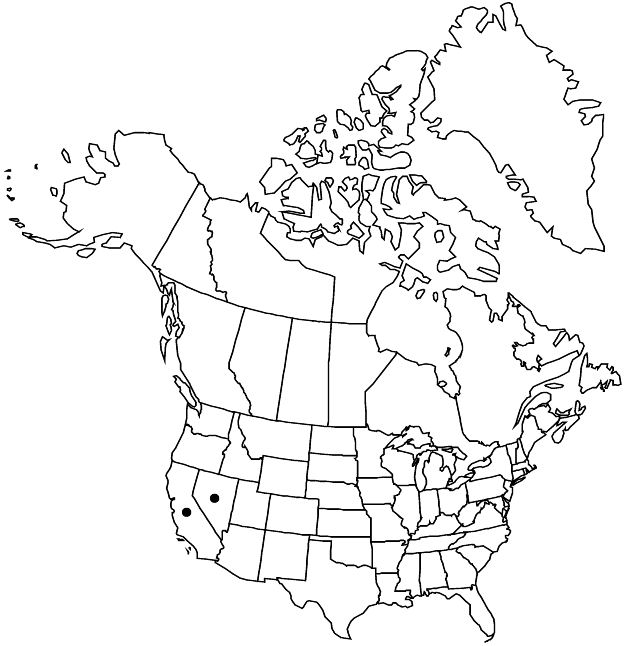Difference between revisions of "Rosa woodsii subsp. gratissima"
Novon 17: 351. 2007.
FNA>Volume Importer |
FNA>Volume Importer |
||
| Line 12: | Line 12: | ||
|label=Endemic | |label=Endemic | ||
}} | }} | ||
| − | |basionyms={{Treatment/ID/ | + | |basionyms={{Treatment/ID/Basionym |
|name=Rosa gratissima | |name=Rosa gratissima | ||
|authority=Greene | |authority=Greene | ||
| + | |publication_title=Fl. Francisc., | ||
| + | |publication_place=73. 1891 | ||
}} | }} | ||
|synonyms={{Treatment/ID/Synonym | |synonyms={{Treatment/ID/Synonym | ||
| Line 37: | Line 39: | ||
|elevation=800–3400 m | |elevation=800–3400 m | ||
|distribution=Calif.;Nev. | |distribution=Calif.;Nev. | ||
| − | |discussion=<p>Subspecies gratissima is diploid [2x (DNA)]. It occurs on mountains in and adjacent to the Mojave Desert of southeastern California and southern <i>Nevada</i>, US Highway 50 across central <i>Nevada</i> approximately coinciding with the boundary with <i></i>subsp.<i> ultramontana</i>. Plants tend to be densely branched with abundant, relatively stout prickles extending into the inflorescence.</p><!-- | + | |discussion=<p>Subspecies gratissima is diploid [2x (DNA)]. It occurs on mountains in and adjacent to the Mojave Desert of southeastern California and southern <i>Nevada</i>, US Highway 50 across central <i>Nevada</i> approximately coinciding with the boundary with <i></i></i>subsp.<i><i> ultramontana</i>. Plants tend to be densely branched with abundant, relatively stout prickles extending into the inflorescence.</p><!-- |
| − | --><p>Within <i></i>subsp.<i> gratissima</i>, localized clusters of glabrous populations on the northern foot of the San Bernardino Mountains represent <i></i>var.<i> glabrata</i> (Parish) D. Cole (basionym <i>R. californica</i> Chamisso & Schlechtendal <i></i>var.<i> glabrata</i> Parish); R. mohavensis Parish is a homotypic synonym and <i>R. woodsii</i> <i></i>var.<i> mohavensis</i> (Parish) Jepson is superfluous and illegitimate. Conservative attention to <i></i>var.<i> glabrata</i> is warranted. The remainder of <i></i>subsp.<i> gratissima</i> is var. gratissima. A. Cronquist and N. H. Holmgren (1997) identified the NY syntype of R. gratissima as <i>R. californica</i>; the holotype (NDG 23620) clearly falls within the circumscription here.</p> | + | --><p>Within <i></i></i>subsp.<i><i> gratissima</i>, localized clusters of glabrous populations on the northern foot of the San Bernardino Mountains represent <i></i></i>var.<i><i> glabrata</i> (Parish) D. Cole (basionym <i>R. californica</i> Chamisso & Schlechtendal <i></i></i>var.<i><i> glabrata</i> Parish); R. mohavensis Parish is a homotypic synonym and <i>R. woodsii</i> <i></i></i>var.<i><i> mohavensis</i> (Parish) Jepson is superfluous and illegitimate. Conservative attention to <i></i></i>var.<i><i> glabrata</i> is warranted. The remainder of <i></i></i>subsp.<i><i> gratissima</i> is var. gratissima. A. Cronquist and N. H. Holmgren (1997) identified the NY syntype of R. gratissima as <i>R. californica</i>; the holotype (NDG 23620) clearly falls within the circumscription here.</p> |
|tables= | |tables= | ||
|references= | |references= | ||
| Line 62: | Line 64: | ||
|publication year=2007 | |publication year=2007 | ||
|special status=Endemic | |special status=Endemic | ||
| − | |source xml=https://jpend@bitbucket.org/aafc-mbb/fna-data-curation.git/src/ | + | |source xml=https://jpend@bitbucket.org/aafc-mbb/fna-data-curation.git/src/f6b125a955440c0872999024f038d74684f65921/coarse_grained_fna_xml/V9/V9_160.xml |
|subfamily=Rosaceae subfam. Rosoideae | |subfamily=Rosaceae subfam. Rosoideae | ||
|tribe=Rosaceae tribe Roseae | |tribe=Rosaceae tribe Roseae | ||
Revision as of 21:35, 24 September 2019
Shrubs, usually 10–30(+) dm. Stems densely branched; prickles present on distal stems and branches, infrastipular erect or curved, subulate or stout, 2–10(–13) mm, internodal usually abundant. Terminal leaflets ovate-elliptic, sometimes obovate, 9–28 mm. Inflorescences 1–3(–5+)-flowered, sometimes 10(–15)-flowered. Sepals: abaxial surfaces eglandular, rarely stipitate-glandular.
Phenology: Flowering May–Aug.
Habitat: Mountain and desert springs, along streams, moist canyons, slopes, yellow pine forests
Elevation: 800–3400 m
Discussion
Subspecies gratissima is diploid [2x (DNA)]. It occurs on mountains in and adjacent to the Mojave Desert of southeastern California and southern Nevada, US Highway 50 across central Nevada approximately coinciding with the boundary with subsp. ultramontana. Plants tend to be densely branched with abundant, relatively stout prickles extending into the inflorescence.
Within subsp. gratissima, localized clusters of glabrous populations on the northern foot of the San Bernardino Mountains represent var. glabrata (Parish) D. Cole (basionym R. californica Chamisso & Schlechtendal var. glabrata Parish); R. mohavensis Parish is a homotypic synonym and R. woodsii var. mohavensis (Parish) Jepson is superfluous and illegitimate. Conservative attention to var. glabrata is warranted. The remainder of subsp. gratissima is var. gratissima. A. Cronquist and N. H. Holmgren (1997) identified the NY syntype of R. gratissima as R. californica; the holotype (NDG 23620) clearly falls within the circumscription here.
Selected References
None.
